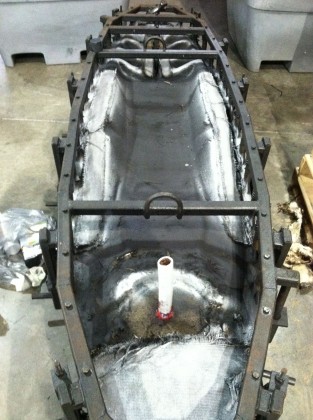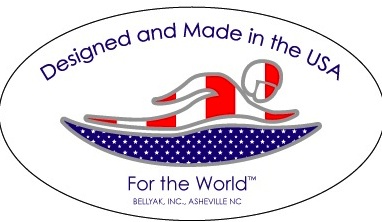Outdoor Retailer Bound!
We’ve packed the truck, built the booth, packed everything and checked it all twice. We are headed to our largest tradeshow of the year.
We’ve packed the truck, built the booth, packed everything and checked it all twice. We are headed to our largest tradeshow of the year.
Everybody talks about “Made in the USA.” Here at Bellyak, Inc, we are 100% made in the USA. Sure, we could have our boats made in China for a lot cheaper, and we could sell our boats for less. However, not many people know what goes into making a plastic boat, and the quality control measures necessary to make an excellent product.

Almost all plastic kayaks on the market are rotationally molded. Think of rotational molding this way: Imagine a glass jar. Now imagine taking a candle and shaving small bits of wax into this jar. Then imagine the jar being heated over a candle while being rotated and rocked back and forth. The wax melts and coats the inside of the jar. Now imagine breaking this jar, and inside you have a mold of the jar. This is rotomolding in a nutshell (or in a jar…). To make a kayak, polyethylene powder is placed in an aluminum mold (wax shavings in a jar), and then cooked at approximately 600 degrees while rotating in two directions. What comes out is a tough and durable plastic boat. Before roto molding kayaks were typically made of fiberglass, which although light and stiff, was fragile and unable to stand up to the demands of rocky rivers without frequent repairs. A quick note on the history of rotational molding in the kayak industry:
My dad, Bill Masters, was the leading innovator in roto-molding for kayaks with his company, Perception Kayaks. My dad built his first ovens in Liberty SC and turned out boats such as the Quest, the Spirit and the Mirage in the early 80’s. The most sold kayak of all time was the Dancer, designed by my dad and my uncle Allen Stancil, and named by my mom, Janet. Bill Masters contributions to manufacturing innovation in the kayak industry are unsurpassed…few people outside the industry recognize his long reaching effect on the sport. He effectively took kayaking from a fringe sport enjoyed by a few and helped make it the multi million dollar industry it is today (props to you, dad). So it’s only natural that his progeny continue on in the family business…face first.
You might be wondering “How does a concept or an idea turn into a plastic boat that can be paddled?”
The first bellyaks I built were made out of foam and fiberglass. After going through approximately 25 iterations, I decided to create a design that could be rotomolded.
First, the boat design is translated into CAD….in other words, a digital image of the boat is created from the physical prototypes. Evan Solida, of 6ix Design, has been instrumental in helping me translate my rough prototypes into digital models. Back in the dark ages of kayak design, before internet and when people still had home phones, this was all done by hand. People like Allen Stancil and Jim Snyder would painstakingly carve every single facet of a “plug” before making a mold. This is an art form that is under appreciated by many of todays modern kayakers who aren’t familiar with what goes into designing a boat….a lot of work, a lot of dust, and plenty of trial and error.
However, in the past twenty years huge strides have happened with technology and boat design. Now, boat design happens in the virtual world, where edits that would have taken weeks to make by hand can be completed in a matter of minutes by a skilled CAD driver.

This is my caption
Once this is dialed in, and edits made, a CNC machine (think a super smart robot cutter) cuts an exact image of the digital model out of dense foam. Our CNC cutter is Tom McGuire of Digital Designs in Winston Salem, NC. In the photos below, the first photo shows the Frequency right after being cut. The second photo shows the same plug, but after being sprayed with primer and sanded to a super smooth finish. Once this was done, we shipped the plug off to a foundry in Texas, where our aluminum mold was cast.
The image on the left is the mold prior to strategic shielding, and the image on the right is after modifying the mold. I used silver paint to reflect heat (reduces thickness of the plastic) and black paint to absorb heat (increases thickness of the plastic). I also shielded the front of the mold to reduce the amount of plastic that builds up on the ends. These are tricks I learned from being around rotational molding my whole life. What does this mean to you? It means I created a stiffer, lighter boat by working with the molders. Another reason why we chose to be 100% made in the USA. We were able to get the weight of the bellyak down from 35 pounds to 29.5 pounds, while increasing the stiffness in key areas.
IÛªm Anna, wife of Adam, and here to tell you what itÛªs been like watching the development of the bellyak from my perspective. åÊIf youÛªre interested in polyethylene, foam and fiberglass, you will not be interested in what I have to say. åÊIf you only want to hear about how extreme this boat can be, go ahead and click onto another post from Adam. åÊIf, however, you are someone who is new to whitewater, maybe a little afraid of trying kayaking for fear of being trapped in a boat, or you just want a sweet little love story, read on.
So IÛªve always liked water, but notåÊloved it. åÊI know, to all you hard core paddlers out there, you must think IÛªm weak. åÊIt was just never my thing. åÊI love beingåÊnear the water! åÊTo stand on a sandy beach and look out over the expanse of ocean-like the rest of the Earth is just beyond the end of the horizon-is an unmatched feeling. åÊI grew up in Western North Carolina, 4 miles from the French Broad River. åÊIt always felt like a part of me, like somehow that murky water was in my DNA. However, due to my immense respect for the power of water I was always happy enough to just look at it, watch the waves curl white over the rocky surfaces. åÊMy family would take a rafting trip once a year down the river with the French Broad Rafting Co. åÊIt was great! åÊI loved being on the waterÛ_but my exploration ended there. åÊWhat was my next option? CanoeÛ_.not interested. I tried a Ducky years laterÛ_fun and safe, right up my alley. åÊBut to kayakÛ_this is where my relationship with the river ended. åÊI couldnÛªt get past the spray skirt. åÊIt seemed like too steep a learning curve. åÊI am HUGELY impressed by all whoåÊcan get in a sprayskirt and learn to roll, or at least face that challenge. åÊBut, so sorry, NOT for me!
Fast forward several years, and I met Adam Masters. åÊ**Cue wedding music** We met, fell in love, got hitched. åÊOhhÛ_how sweet! åÊ Unlike me, Adam has been in and on water his entire life-kayaking since 6 yrs old. åÊWhat does this have anything to do with the bellyak? åÊIÛªm getting thereÛ_
As we develop and test the boats, we have to get them out on the water to feel how they do. åÊIÛªve watched and helped Adam develop and design the boats for the past year now from the perspective of someone who is green to the river. åÊFor months, I was the wimp whining, ÛÏit hurts my neck! åÊWe need to steepen the curve of the chest cavity.Û Or, ÛÏI feel too insecure, out of controlÛ helped realize a deeper body cavity to lower the center of gravity and soften the edges of the boat so it was less tippy. åÊI canÛªt tell you how many times Adam would lead me through a rapid and immediately turn around once through, only to see me getting flipped and dumped on some benign rapid. åÊWhat came out of all this was some perspective of those who donÛªt know water as well. åÊItÛªs definitely an art. åÊThereÛªs a whole language in how the water moves and as someone without all the experience, it was important that the boats could be ridden by everyone, even us newbies. åÊAnd thereÛªs plenty of us out there! Kayakers are amazing. åÊThey can take a boat beyond the limits of what seems sane, safe, or possible. åÊBut there are also lots of people who simply want to have a fun and safe experience. åÊWeÛªre hopeful that the boat can provide this for youÛÒespecially the FrequencyÛÒour more stable of the two models.
What the bellyak has done for me: åÊIÛªve taken the bellyak down sections of river I never would have seen before unless in a raft or ducky. åÊNot only that, but the vantage point isåÊentirely different! åÊIt is so much more intimate as the water splashes up and down the body of the rider. åÊItÛªs not like sitting up and above the waterÛÒyouÛªreåÊin it on the bellyak! åÊThe bellyak has helped me get out and see places I probably never would have. åÊIt has provided me with another way to encounter the water and to go places I likely wouldnÛªt have traversed. åÊWe live in such an amazingly beautiful and rich planet. åÊTo be out on a river or out in the ocean surf and feel safe is such a gift.
So I encourage all of you who may be too timid to try kayaking to try bodyboating in a bellyak. åÊIt might just do for you what it did for me.